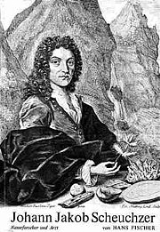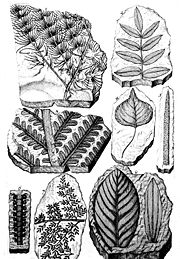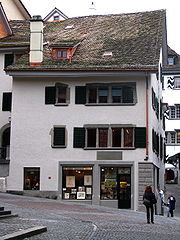
Johann Jakob Scheuchzer
Encyclopedia
Johann Jakob Scheuchzer was a Swiss
scholar born at Zürich
.



(Archiater) of Zürich, he received his education in that place, and, in 1692, went to the University of Altdorf
near Nuremberg
, being intended for the medical profession. Early in 1694 he took his degree of doctor in medicine at the University of Utrecht
, and then returned to Altdorf, Germany
to complete his mathematical studies. He went back to Zürich in 1696 and was made junior town physician (Poliater) with the promise of the professorship of mathematics which he duly obtained in 1710. He was promoted to the chair of physics, with the office of senior town physician, in January 1733, only a few months before his death on June 23.
, under the title of Naturgeschichte des Schweitzerlandes sammt seinen Reisen über die schweitzerischen Gebirge, and his Helvetiae historia naturalis oder Naturhistorie des Schweitzerlandes (published in 3 vols, at Zürich, 1716–1718, and reissued in the same form in 1752, under the German title just given). The first of the three parts of the last-named work deals with the Swiss mountains (summing up all that was then known about them, and serving as a link between Simmler
's work of 1574 and Gruner
's of 1760), the second with the Swiss rivers, lakes and mineral baths, and the third with Swiss meteorology and geology.
Scheuchzer’s works, as issued in 1746 and in 1752, formed (with Tschudi
's Chronicum Helveticum) one of the chief sources for Schiller
's drama Wilhelm Tell
(1804). In 1704 Scheuchzer was elected FRS; he published many scientific notes and papers in the Philosophical Transactions for 1706-1707, 1709 and 1727-1728.
in 1708, and dedicated to the Royal Society
, while the plates illustrating it were executed at the expense of various fellows of the society, including the president, Sir Isaac Newton
(whose imprimatur
appears on the title-page), Sir Hans Sloane
, Dean Aldrich
, Humfrey Wanley
, etc. The text is written in Latin
, as is that of the definitive work describing his travels (with which is incorporated the 1708 volume) that appeared in 1723 at Leiden, in four quarto volumes, under the title of Itinera per Helvetiae alpinas regiones facta annis 1702-1711.
These journeys led Scheuchzer to almost every part of Switzerland, particularly its central and eastern districts. Apropos of his visit (1705) to the Rhône Glacier
, he inserts a full account of the other Swiss glaciers, as far as they were then known, while in 1706, after mentioning certain wonders to be seen in the museum at Lucerne
, he adds reports by men of good faith who had seen dragons in Switzerland. He doubts their existence, but illustrates the reports by fanciful representations of dragons, which have led some modern writers to depreciate his merits as a traveller and naturalist, for the belief in dragons was then widely spread.
In 1712 he published a map of Switzerland in four sheets (scale 1/290,000), of which the east portion (based on his personal observations) is far the most accurate, though the map as a whole was the best map of Switzerland till the end of the 18th century. At the end of his 1723 book he gives a full list (covering 27 4to pages) of his writings from 1694 to 1721.
Scheuchzer is also known for his paleontological work. In his Lithographia Helvetica, he described fossils as "plays of nature" or alternately as leftovers from the biblical Flood. Most famously, he claimed that a fossilized skeleton found in a Baden
quarry was the remains of a human who had perished in the deluge. This claim, which seemed to verify the claims of Christian scripture, was accepted for several decades after Scheuchzer's death, until 1811, when French naturalist Georges Cuvier
re-examined the specimen and showed that it was actually a large prehistoric salamander.
Scheuchzerhorn
(3462 m) and Scheuchzerjoch in the Bernese Alps
are named after Johann Jakob Scheuchzer. Scheuchzeriaceae
and Scheuchzeria palustris are named in his honor.
Switzerland
Switzerland name of one of the Swiss cantons. ; ; ; or ), in its full name the Swiss Confederation , is a federal republic consisting of 26 cantons, with Bern as the seat of the federal authorities. The country is situated in Western Europe,Or Central Europe depending on the definition....
scholar born at Zürich
Zürich
Zurich is the largest city in Switzerland and the capital of the canton of Zurich. It is located in central Switzerland at the northwestern tip of Lake Zurich...
.



Career
The son of the senior town physicianPhysician
A physician is a health care provider who practices the profession of medicine, which is concerned with promoting, maintaining or restoring human health through the study, diagnosis, and treatment of disease, injury and other physical and mental impairments...
(Archiater) of Zürich, he received his education in that place, and, in 1692, went to the University of Altdorf
University of Altdorf
The University of Altdorf was a university in Altdorf bei Nürnberg, a small town outside Nuremberg. It was founded in the late 16th century, received university privileges in 1622 and was closed in 1809 by Maximilian I Joseph of Bavaria....
near Nuremberg
Nuremberg
Nuremberg[p] is a city in the German state of Bavaria, in the administrative region of Middle Franconia. Situated on the Pegnitz river and the Rhine–Main–Danube Canal, it is located about north of Munich and is Franconia's largest city. The population is 505,664...
, being intended for the medical profession. Early in 1694 he took his degree of doctor in medicine at the University of Utrecht
Utrecht University
Utrecht University is a university in Utrecht, Netherlands. It is one of the oldest universities in the Netherlands and one of the largest in Europe. Established March 26, 1636, it had an enrollment of 29,082 students in 2008, and employed 8,614 faculty and staff, 570 of which are full professors....
, and then returned to Altdorf, Germany
Altdorf bei Nürnberg
Altdorf bei Nürnberg is a town in south-eastern Germany. It is situated 25 km east of Nuremberg, in the district Nürnberger Land. Its name literally means Altdorf near Nuremberg, to distinguish it from other Altdorfs.-History:...
to complete his mathematical studies. He went back to Zürich in 1696 and was made junior town physician (Poliater) with the promise of the professorship of mathematics which he duly obtained in 1710. He was promoted to the chair of physics, with the office of senior town physician, in January 1733, only a few months before his death on June 23.
Published Works
His published works (apart from numerous articles) were estimated at thirty-four in number. His historical writings are mostly still in manuscript. The more important of his published writings relate either to his scientific observations (all branches) or to his journeys, in the course of which he collected materials for these scientific works.Scientific works
In the former category is his self-published Beschreibung der Naturgeschichte des Schweitzerlandes (3 vols., Zürich, 1706–1708), the third volume containing an account in German of his journey of 1705; a new edition of this book and, with important omissions, of his 1723 work, was issued, in 2 vols, in 1746, by JG SulzerJohann Georg Sulzer
Johann Georg Sulzer was a Swiss professor of Mathematics, who later on moved on to the field of electricity. He was a Wolffian philosopher and director of the philosophical section of the Berlin Academy of Sciences....
, under the title of Naturgeschichte des Schweitzerlandes sammt seinen Reisen über die schweitzerischen Gebirge, and his Helvetiae historia naturalis oder Naturhistorie des Schweitzerlandes (published in 3 vols, at Zürich, 1716–1718, and reissued in the same form in 1752, under the German title just given). The first of the three parts of the last-named work deals with the Swiss mountains (summing up all that was then known about them, and serving as a link between Simmler
Josias Simmler
Josias Simmler , was a Swiss theologian and classicist, author of the first book relating solely to the Alps.-Life:...
's work of 1574 and Gruner
Gottlieb Sigmund Gruner
Gottlieb Sigmund Gruner , cartographer and geologist, was the author of the first connected attempt to describe in detail the snowy mountains of Switzerland....
's of 1760), the second with the Swiss rivers, lakes and mineral baths, and the third with Swiss meteorology and geology.
Scheuchzer’s works, as issued in 1746 and in 1752, formed (with Tschudi
Aegidius Tschudi
Aegidius Tschudi was an eminent member of the Tschudi family, of Glarus, Switzerland....
's Chronicum Helveticum) one of the chief sources for Schiller
Friedrich Schiller
Johann Christoph Friedrich von Schiller was a German poet, philosopher, historian, and playwright. During the last seventeen years of his life , Schiller struck up a productive, if complicated, friendship with already famous and influential Johann Wolfgang von Goethe...
's drama Wilhelm Tell
Wilhelm Tell (play)
William Tell is a drama written by Friedrich Schiller in 1804. The story focuses on the legendary Swiss marksman William Tell as well as on the Swiss struggle for independence from the Habsburg Empire in the early 14th century...
(1804). In 1704 Scheuchzer was elected FRS; he published many scientific notes and papers in the Philosophical Transactions for 1706-1707, 1709 and 1727-1728.
Travel works
In the second category are his Itinera alpina tria (made in 1702-1704), which was published in LondonLondon
London is the capital city of :England and the :United Kingdom, the largest metropolitan area in the United Kingdom, and the largest urban zone in the European Union by most measures. Located on the River Thames, London has been a major settlement for two millennia, its history going back to its...
in 1708, and dedicated to the Royal Society
Royal Society
The Royal Society of London for Improving Natural Knowledge, known simply as the Royal Society, is a learned society for science, and is possibly the oldest such society in existence. Founded in November 1660, it was granted a Royal Charter by King Charles II as the "Royal Society of London"...
, while the plates illustrating it were executed at the expense of various fellows of the society, including the president, Sir Isaac Newton
Isaac Newton
Sir Isaac Newton PRS was an English physicist, mathematician, astronomer, natural philosopher, alchemist, and theologian, who has been "considered by many to be the greatest and most influential scientist who ever lived."...
(whose imprimatur
Imprimatur
An imprimatur is, in the proper sense, a declaration authorizing publication of a book. The term is also applied loosely to any mark of approval or endorsement.-Catholic Church:...
appears on the title-page), Sir Hans Sloane
Hans Sloane
Sir Hans Sloane, 1st Baronet, PRS was an Ulster-Scot physician and collector, notable for bequeathing his collection to the British nation which became the foundation of the British Museum...
, Dean Aldrich
Henry Aldrich
Henry Aldrich was an English theologian and philosopher.-Life:Aldrich was educated at Westminster School under Dr Richard Busby. In 1662, he entered Christ Church, Oxford, and in 1689 was made Dean in succession to the Roman Catholic John Massey, who had fled to the Continent. In 1692, he...
, Humfrey Wanley
Humfrey Wanley
Humfrey Wanley was a librarian, palaeographer and scholar of Old English, employed by manuscript collectors such as Robert and Edward Harley. He was the first keeper of the Harlein Library, now the Harleian Collection.-Life:...
, etc. The text is written in Latin
Latin
Latin is an Italic language originally spoken in Latium and Ancient Rome. It, along with most European languages, is a descendant of the ancient Proto-Indo-European language. Although it is considered a dead language, a number of scholars and members of the Christian clergy speak it fluently, and...
, as is that of the definitive work describing his travels (with which is incorporated the 1708 volume) that appeared in 1723 at Leiden, in four quarto volumes, under the title of Itinera per Helvetiae alpinas regiones facta annis 1702-1711.
These journeys led Scheuchzer to almost every part of Switzerland, particularly its central and eastern districts. Apropos of his visit (1705) to the Rhône Glacier
Rhône Glacier
The Rhone Glacier, or sometimes Rhône Glacier is a glacier in the Swiss Alps and the source of the Rhone River and one of the primary contributors to Lake Geneva in the far eastern end of the Swiss canton of Valais...
, he inserts a full account of the other Swiss glaciers, as far as they were then known, while in 1706, after mentioning certain wonders to be seen in the museum at Lucerne
Lucerne
Lucerne is a city in north-central Switzerland, in the German-speaking portion of that country. Lucerne is the capital of the Canton of Lucerne and the capital of the district of the same name. With a population of about 76,200 people, Lucerne is the most populous city in Central Switzerland, and...
, he adds reports by men of good faith who had seen dragons in Switzerland. He doubts their existence, but illustrates the reports by fanciful representations of dragons, which have led some modern writers to depreciate his merits as a traveller and naturalist, for the belief in dragons was then widely spread.
In 1712 he published a map of Switzerland in four sheets (scale 1/290,000), of which the east portion (based on his personal observations) is far the most accurate, though the map as a whole was the best map of Switzerland till the end of the 18th century. At the end of his 1723 book he gives a full list (covering 27 4to pages) of his writings from 1694 to 1721.
Scheuchzer is also known for his paleontological work. In his Lithographia Helvetica, he described fossils as "plays of nature" or alternately as leftovers from the biblical Flood. Most famously, he claimed that a fossilized skeleton found in a Baden
Baden
Baden is a historical state on the east bank of the Rhine in the southwest of Germany, now the western part of the Baden-Württemberg of Germany....
quarry was the remains of a human who had perished in the deluge. This claim, which seemed to verify the claims of Christian scripture, was accepted for several decades after Scheuchzer's death, until 1811, when French naturalist Georges Cuvier
Georges Cuvier
Georges Chrétien Léopold Dagobert Cuvier or Jean Léopold Nicolas Frédéric Cuvier , known as Georges Cuvier, was a French naturalist and zoologist...
re-examined the specimen and showed that it was actually a large prehistoric salamander.
Honours and Awards
In November 1703 he was elected a Fellow of the Royal Society.Scheuchzerhorn
Scheuchzerhorn
Scheuchzerhorn is a mountain in the Bernese Alps in Switzerland.-External links:*...
(3462 m) and Scheuchzerjoch in the Bernese Alps
Bernese Alps
The Bernese Alps are a group of mountain ranges in the western part of the Alps, in Switzerland. Although the name suggests that they are located in the Bernese Oberland region of the canton of Bern, portions of the Bernese Alps are in the adjacent cantons of Valais, Lucerne, Obwalden, Fribourg and...
are named after Johann Jakob Scheuchzer. Scheuchzeriaceae
Scheuchzeriaceae
Scheuchzeria palustris , is a flowering plant, the only species in the genus Scheuchzeria, itself the only genus in the family Scheuchzeriaceae...
and Scheuchzeria palustris are named in his honor.
External links
- Herbarium diluvianum, 1723.

